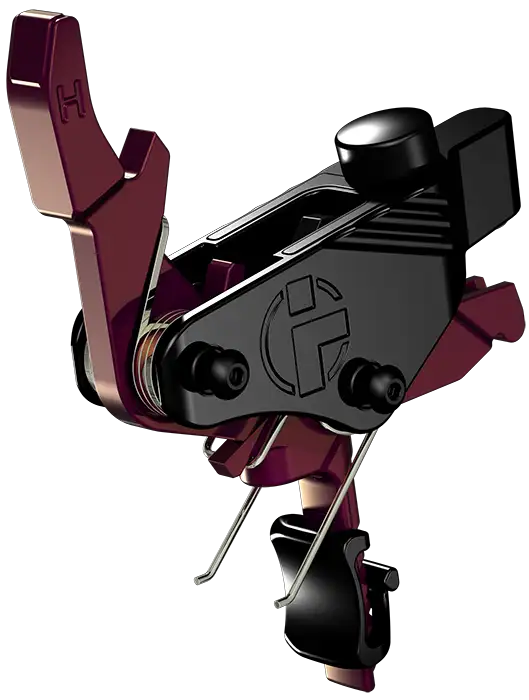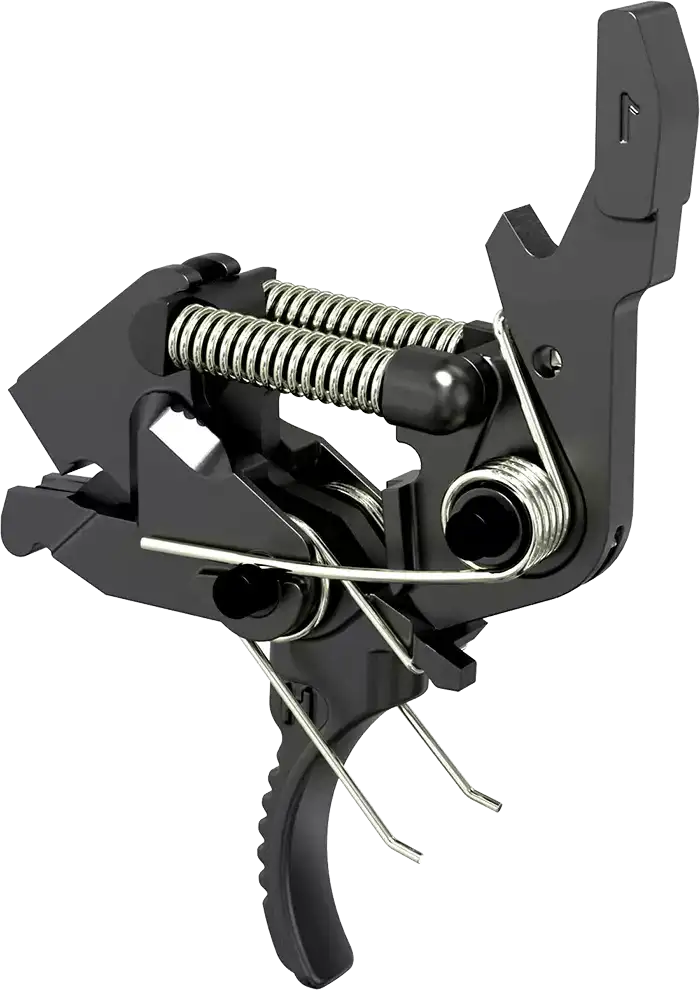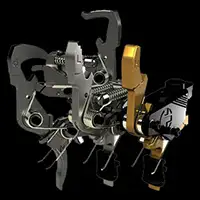The triggers are ready to go when installed correctly-. However, the initial feel will change over several tens of dry- or live-fires. Why is this?
The triggers are finished with a MIL-spec process called Parkerize, or heavy Manganese Phosphate, as a rust preventive finish (except for the TH24 with the special Nickel plating). When the trigger is pulled and breaks, releasing the hammer to strike the firing pin, the trigger and hammer sear surfaces scrub off the Parkerize exposing the bare metal. During the process, the feel will change slightly. In fact, initial measurements of trigger weight are unreliable for this reason. But, after 100-200 cycles, the feel and weight will stabilize as the sear completes the self polishing process.
Initial weight and feel is also a strong function of spring break-in, especially the hammer spring. After any of the springs are formed, they are heat treated to remove residual stress. The wire surface becomes noticeably rough. Wires that slide on one another exhibit noticeably high friction. The hammer spring is a double-torsion spring. When the hammer is cocked and when the hammer falls, the coils slide on one another. Initially, this sliding friction is very high. This will contribute to variable trigger weight measurement during initial hammer cocks and falls because the hammer spring supplies all of the friction force on the sear. This hammer spring effect is especially operative on the 24 series triggers, which share the toggle spring system, which makes for a more sensitive tactile feedback that many shooters desire. During the 100-200 dry fires noted above, the hammer spring friction effect is eliminated after repetitive sliding of the coil wires has developed self polished interfacial surfaces. It is not expected that any reviewer would be aware of these facts. Nonetheless, it might have affected the review findings or perceptions.
Terry Bender
Terry Bender is HIPERFIRE®'s CEO and runs R&D. He has over 40 years of experience in product and manufacturing process development, private consulting in forensics, failure analysis, and remediation using computational analytic tools. He began designing a firearm about 20 years ago as a personal curiosity. The rest is history.
Safety/Selectors: HIPERFIRE® knows of six safety selectors that will not work with HIPERTOUCH® 24 series triggers:
- Seekins Precision Ambi Safety (60 and 90 deg throws)
- V SEVEN HYBRID 3 GUN/SPORT SELECTORS
- Elftmann Slide Safety Selector
- Talon Ambidextrous 45/90 Safety Selector
- BAD-CASS or BAD-ASS Short Throw Safety Selector
- KE Arms Ambi Safety Selector (45/90 deg throws)
HIPERTOUCH® 24 Series Triggers
The frame component of the HIPERTOUCH® 24 FCG that provides the toggle spring system support is designed to ride on the barrel of semi-auto or “MIL-spec” safety/selectors (not full-auto). This permits normal functional rotation of the safety/selector. An aside: when the FCGs are first installed, some users will notice a little grit during rotation, which is a function of the surface finish on the safety/selector barrel. With a few cycles it will smooth out as the frame and safety/selector self polish.
The ambi safeties listed above do not have a large contiguous cylindrical barrel surface like the stock version; two or more channels or a small diameter barrel have been cut into them that accepts the rear of the trigger when pulled into over travel. The toggle spring frame drops into these channels, which not only relieves necessary compression of the toggle springs but may also prevent free rotation of the safety/selector or even cause rotation of the selector during repeat fire as in the number two case above.
HIPERTOUCH® EDT Series Trigger
The Seekins works in 60 deg throw mode in SAFE and FIRE w/o issue. However, in 90 deg throw mode, the trigger will rotate enough to release the hammer. This is because the trigger tail is shorter than MIL/stock triggers and can move up into the exposed Seekins SS slot just enough to release the hammer when pulled.
Other Ambi Controls: The ambi bolt catch on S&W M&P10s interferes with free rotation of HIPERTOUCH® 24 series triggers. Users have simply removed the ambi control and restored proper function of the 24 series FCG. Some safety selectors, such as the JP Adjustable/Reversible Safety Selector, have adjustable set screws and locking screws that eliminate sear/trigger travel. HIPERFIRE® recommends you review the selector manufacturer’s installation instructions to ensure proper selector function.
Terry Bender
Terry Bender is HIPERFIRE®'s CEO and runs R&D. He has over 40 years of experience in product and manufacturing process development, private consulting in forensics, failure analysis, and remediation using computational analytic tools. He began designing a firearm about 20 years ago as a personal curiosity. The rest is history.
This question is directed to HIPERFIRE® in many different variations through your CONTACT page submittals and phone calls. In the vast majority of cases the answer is YES, the user has done something wrong and it takes some well placed questions on our part and your considered answers for us to figure out what’s wrong. Normally, if we had the lower in front of us, we could see immediately what the issue is and fix it. But, we don’t.
So, we’ve put together this PDF Trouble Shooting Guide (click the highlighted words to read it online or download it to your computer or mobile device). It’s based on actual case histories brought to us for successful remediation. We are happy to inform you, that we have found no situation where the fire control has not been made to function as advertised by making a few simple observations and apply some common sense.
.
Terry Bender
Terry Bender is HIPERFIRE®'s CEO and runs R&D. He has over 40 years of experience in product and manufacturing process development, private consulting in forensics, failure analysis, and remediation using computational analytic tools. He began designing a firearm about 20 years ago as a personal curiosity. The rest is history.
The HIPERTOUCH® family of triggers were designed to function with a consistent feel whether lubricated or not, i.e. for the worst case, when proper maintenance and lubrication are impossible: the battlefield environment. HIPERFIRE® has live-fired triggers in excess of 100k rounds without lubrication, without hiccup, or change in trigger feel. This is because the sear contact surfaces are large and robust in the first place, limiting excessive wear, and in the second place carry lighter contact impingement loads than competing products due to the addition of the toggle springs. Since the sear load is reduced, the wear is reduced.
Theoretically, using lubrication will increase product longevity versus running the triggers without lubrication. Good lubricants will make clean up and maintenance easier as well, but will not significantly improve feel. Why? Lubricating films generally improve lubricity when the contact surfaces are mutually large and in close intimate conformal contact. The film between these surfaces is pressurized to some slight degree (a function of the lubricant’s viscosity among other factors) and prevents or inhibits metal-to-metal direct sliding, thereby reducing the friction coefficient and reducing wear. However, in every fire-control design including HIPERTOUCH®, the trigger sear edge and not a broad conformal surface interacts with the hammer sear surface so that film pressure, for practical purposes, is nonexistent, i.e. the difference in pull weight between lubricated and non-lubricated HIPERTOUCH® FCGs is insignificant.
Having said all that, any lubricant will extend wear life.
Terry Bender
Terry Bender is HIPERFIRE®'s CEO and runs R&D. He has over 40 years of experience in product and manufacturing process development, private consulting in forensics, failure analysis, and remediation using computational analytic tools. He began designing a firearm about 20 years ago as a personal curiosity. The rest is history.
This chart was constructed from test data that HIPERFIRE® generated to compare hammer fall energies of various products to HIPERTOUCH®. Three different measurement bars are shown for HIPERTOUCH® triggers representing the installation of the three different toggle spring pairs that come with the products. The spring pairs determine both trigger weight and hammer fall energy. Only one “Top Product” competitor has a hammer fall energy that exceeds the lowest of the two HIPERTOUCH® hammer fall energies. The remaining competitors are decidedly lower in energy, due in large part to employing very low hammer spring power required to meet their goal of lowering trigger pull weight.
The highest hammer fall energy among all the products tested, including the two MIL-spec triggers tested, were the HIPERTOUCH® 24 series triggers with the plain toggle spring pair installed. It provided for both low trigger weight and high energy hammer fall.

Terry Bender
Terry Bender is HIPERFIRE®'s CEO and runs R&D. He has over 40 years of experience in product and manufacturing process development, private consulting in forensics, failure analysis, and remediation using computational analytic tools. He began designing a firearm about 20 years ago as a personal curiosity. The rest is history.
Listed below are the specifications found on each product’s page. The base model is the 24, then the 24Elite, 24 3Gun, and finally the 24Competition. So, listed first are the features of the 24 followed by the additional enhancements up the line. After perusing the specs, also check out the feature chart that shows summarizes the answer to your questions in a graphical format (see Related Articles below-right), or click HIPERTOUCH® AR Trigger Family: Feature Comparison Chart.
Finally, it’s very hard to describe the unique feel of the triggers. Putting your finger on one or more tells you all you need to know.
24 Specifications:
- Drop-In “AR10” and “AR15” Fire-Control
- High Performance, Service Rifle, Trigger Upgrade
- Best-In-Class High Energy Hammer Fall
- 3 User-Adjustable Trigger Weights of 2-4#, Light, Medium-Light, Medium
- ANSI/SAAMI & ITOP (Commerical & MIL) Drop Test Compliant
- Single Stage, Semi-Auto
- For Standard Lower Receivers Using Small Pins of 0.154-inch Diameter
- Uses Stock “AR” Trigger and Semiautomatic Disconnector Springs
- Uses Proprietary Trigger Hammer and Disconnector Parts
- Uses a Proprietary Toggle-Over-Center Spring System
- Smooth/Short Pre-Travel (aka Creep) Like Stock FCGs
- Shorter Travel to Break from Moment of Reset
- Clean Brake
- Best-In-Class Fast/Positive Reset
- 25% to 50% Faster Hammer Lock-Up
- Heat-Treated Alloy Steels
- Installs without Removal of the Safety Selector
- Installs without Modification to the Lower Receiver
- No Screws or Stops to Come Loose
- US Pat. No. 8,572,880, Others Pending
- Made Entirely in the USA by Americans
24E Specs: 24 Specs Plus the Following
- Only a “Hint” of Creep Before Break, Faster On-Demand Performance Compared to the 24
- Like the 24, Creep at Reset Reduced Still More Compared to Creep of Initial Shot
- Desired by DM & LE/SWAT for Long-Range Accuracy, Especially .308
243G Specs: 24, 24E Specs Plus
- At-The-Wall Break Before/After Reset
- Pulls the Same No Matter the Manner of Let-Off
- For 3*Gun, DMR, LE/SWAT
- Very Fast, Consistent, Controllable Repeat Fire
24C Specs: 24, 24E & 243G Specs Plus
- Straight Trigger Bow
- Use w/ or w/o the Proprietary HIPERSHOE™
- 24C Packaged w/ Red Shoe, Black Available Separately
- HIPERSHOE™ Accessory Increases Finger Pad Contact Area for Added Responsiveness
- HIPERSHOE™ Adjusts to 5 Different Detent Positions on Trigger Bow
- 15 Distinct Trigger Weights (3-Springs X 5-Positions = 15)
- Adjust HIPERSHOE™ For Trigger Finger Comfort, Fine-Tuning of Creep, and Weight
Terry Bender
Terry Bender is HIPERFIRE®'s CEO and runs R&D. He has over 40 years of experience in product and manufacturing process development, private consulting in forensics, failure analysis, and remediation using computational analytic tools. He began designing a firearm about 20 years ago as a personal curiosity. The rest is history.
HIPERTOUCH® triggers install in modern sporting rifles (MSR) such as the ubiquitous AR15 and its many multi-caliber variants. HIPERFIRE®’s single-stage, semi-auto, Enhanced Duty Triggers (EDTs) and the 24 series of triggers all operate on the same principles like user-adjustable weights and high hammer fall energy, but with some important differences. The charts below summarizes these key features:
- All the products have 3 or 2 basic user-adjustable trigger weights shown in the top line by the 3 different colored toggle spring set ups in the case of the 24s and 2 different colored hammer hammer spring set ups in the case of the EDTs. The 24C and ECLispe have 5 shoe positions, so they have 3×5=15 different adjustment pull weights. The colored dots on the weight scale correspond to the springs installed by color.
- All the triggers have the highest hammer fall energy of any AR trigger anywhere when using the gray toggle springs (24s) or the red hammer spring (EDTs) and near stock hammer fall power when the others are installed The hammer fall energy is compared to a stock or MIL-spec trigger set up shown in green by and further scaled by mini-bar charts.
- The next three lines highlight specific design shape features.
- The next line, Pre-Travel of Initial Pull, shows how much “creep” is in each HIPERTOUCH® trigger (creep is defined as the distance, or feel, of one metal component sliding on another). This is then compared to a stock or MIL-spec trigger and among one another other using a horizontal, green, baseline, mini-bar chart representing the stock or MIL-spec trigger.
- Importantly, the Pre-Travel from Hammer Reset, shows the amount of creep compared to the creep of the initial pull, i.e. the creep to expect after taking a shot, letting off the trigger and taking a follow-up shot at the point of hammer reset.
- The last line shows the type of cartridge the triggers can handle. The last column shows that an optional spring combination (green toggle springs and red hammer spring) that can also handle 762×39 Russian rounds, which have notoriously hard primers w/ 100% ignition, i.e. no light strikes. Of course, the triggers can also handle 300BLK, 22LR, 9mm, etc.
Again, it’s only a summary. Getting your finger on one or more of the triggers will tell the rest of the story. Contact us if you want more detailed information.
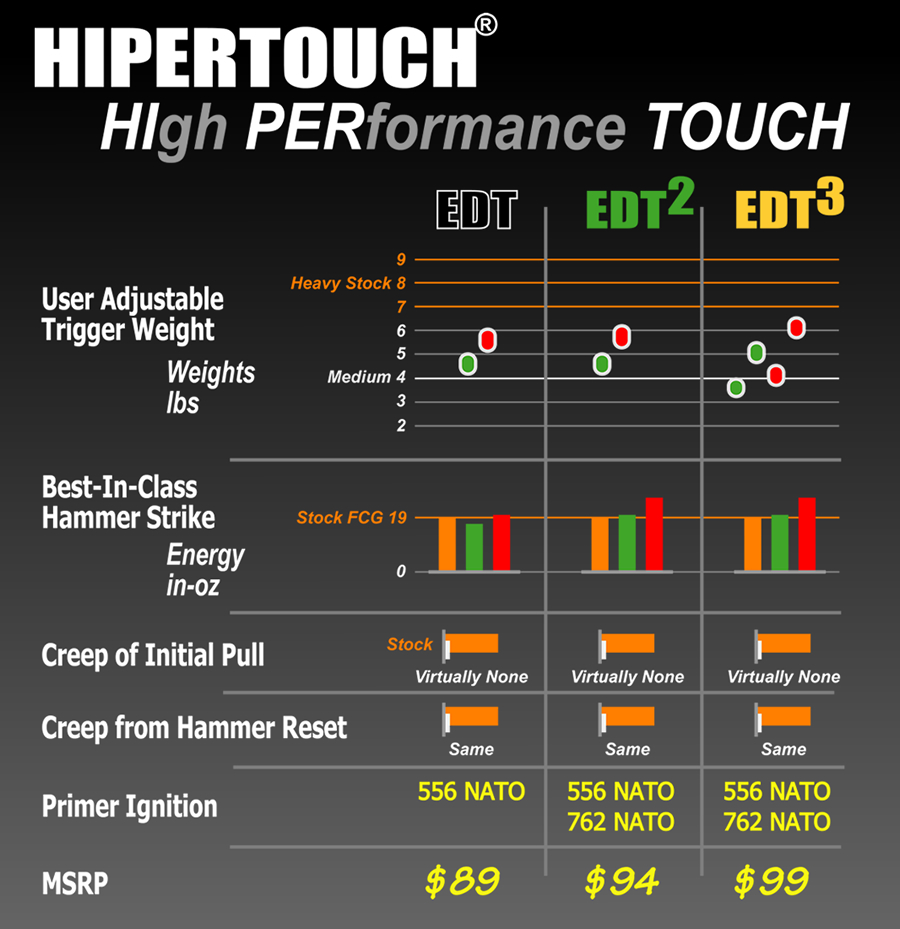
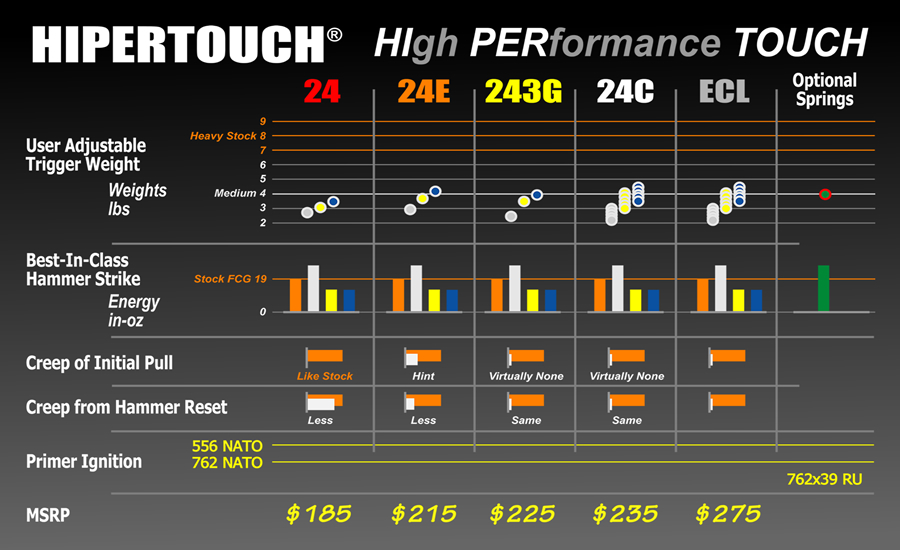
Terry Bender
Terry Bender is HIPERFIRE®'s CEO and runs R&D. He has over 40 years of experience in product and manufacturing process development, private consulting in forensics, failure analysis, and remediation using computational analytic tools. He began designing a firearm about 20 years ago as a personal curiosity. The rest is history.
“Necessity is the mother of invention.” We can’t say why others didn’t see the need. But we did, and developed something novel and useful to meet it. The need: improve finger dexterity and tactile feedback in a trigger for the most demanding shooter, the 3*gun competitor, where high accuracy and fast splits are of paramount importance. Of course you don’t have to be a 3*gunner to appreciate what advantage it could bring to your shooting style.
When the shooter pulls the trigger, the finger moves first. When the finger pad can no longer compress, the trigger begins to move. The amount of finger pad compression is directly related to trigger weight. If the weight is high, the pad compresses more compared to a lighter weighted trigger. Some high-end triggers have a very narrow trigger bow. In those cases, even though the weight is low, the depression produced in the finger pad due to the smaller contact area compared to the normally sized trigger bow’s width. This causes a similar delay in the onset of trigger movement as does a high weight trigger. See? Weight is not the only factor that affects trigger responsiveness. An improvement in the trigger’s responsiveness to our trigger finger is our objective!
One more point before we get to the shoe. The 24C’s trigger bow is straight. Without the shoe, this results in slightly more compression of the finger pad flesh given the same trigger bow width, the same trigger weight, and the same lever arm length (distance of finger pad placement relative to the trigger pivot) than the conventionally curved bow, because it conforms less to the finger pad’s natural curvature. This results in relatively more finger pad compression than the traditionally curved bow. This also explains why every shooter’s experience with a given trigger can be different, because everyone’s trigger finger pad is different, compressing more or less according to their physiology. What the straight bow does provide and that’s why its so attractive to many is that the shooter can modify finger placement and therefore vary slightly the trigger’s creep and weight by adjusting the lever arm length to suit his taste. Of course, this is all the more attractive since the 24C has three different user adjustable weights to begin with, which makes the range of adjustment almost continuous.
Well, using the shoe on the trigger accomplishes two things: first, it increases the trigger finger pad’s surface contact area, which for a given trigger weight, lowers the force exerted by the finger pad necessary to initiate trigger movement. The result is that the trigger “feels” and indeed is more responsive to trigger finger displacement, which translates into a more trigger tactile feedback sensitivity that can enhance performance speed and timing. And by the way, adding the shoe is the only way to make an AR15 trigger wider without opening up the trigger slot in the lower receiver. Second, because the HIPERSHOE®’s position can be indexed to specific locations on the straight trigger bow, the shooter has repeatable control over the placement of his trigger finger. By adjusting the shoe up or down, he can not only fine-tune creep and weight, but absolutely control finger position relative to the grip he’s using for comfort or other reasons. For those reasons we developed the HIPERSHOE® HIgh PERformance SHOE.
Terry Bender
Terry Bender is HIPERFIRE®'s CEO and runs R&D. He has over 40 years of experience in product and manufacturing process development, private consulting in forensics, failure analysis, and remediation using computational analytic tools. He began designing a firearm about 20 years ago as a personal curiosity. The rest is history.
The 24C’s sear design is closer to that of the 24E than the 24, therefore the creep as mesured by instruments is very close to that of the 24E. Moreover, the perceived feel of the 24C is subtly different from the 24E because the trigger bow is flat/straight and the accessory shoe might be employed. Read the FAQ immediately below for an explanation of what the shoe does. Also note, that the 243G is identical to the 24C except for the shape of the bow.
Let’s go into a little more depth. The 24C’s initial creep is a little less than that of the 24E and almost imperceptible. The biggest difference between these two triggers (besides the straight trigger bow and shoe) is that the 24C’s creep (and 243G’s) after reset is the same as its initial creep. With the 24 and 24E, if the shooter can stop trigger let off after touching off a round right after hammer reset and then repeat fire. The repeat fire’s creep is less than the initial creep using this technique. If however, after stopping the trigger after the hammer resets, the shooter decides to let off further, he can feel the little bit of extra forward travel. Pulling the trigger from there resets to the initial creep feel.
With the 24C however, there is no additional let off. This means that the 24C’s creep is the same before and after reset, no matter the shooter’s control over the trigger. It’s like a 1911 single action pull at lower weight with no take up. This is especially important for the 3gunner. A fast repeat habit is easier to develop because the trigger pulls the same each time. For those with a fast twitch trigger finger, split times drop. Faster times and accuracy are a winning combination.
Terry Bender
Terry Bender is HIPERFIRE®'s CEO and runs R&D. He has over 40 years of experience in product and manufacturing process development, private consulting in forensics, failure analysis, and remediation using computational analytic tools. He began designing a firearm about 20 years ago as a personal curiosity. The rest is history.


